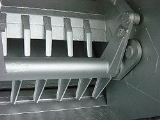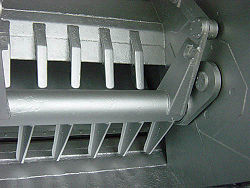
Revopak
Encyclopedia
The Revopak is a type of waste collection vehicle
manufactured by the British company Shelvoke and Drewry
.
Introduced in 1971, the Revopak was in fact a British-built clone of a French Bennes-Ray Superpac. It was among one of the first vehicles to address the problem of compacting and destroying the high content of packaging materials now found in domestic refuse.
By using a huge, hydraulic-powered rotating rake with large steel tines, refuse was scooped up from the loading hopper and forced through a set of stationary tines. The continuous rotation of the rake progressively mangled, mutilated and compacted the refuse so as to reduce the space required to dump it at the landfill
site.
 Two generations of the Revopak were produced - the early 1971-1973 models used hydraulic motors which drove the compaction rake by means of chains, while the later models utilised a simpler and more robust drive system which consisted of twin synchronised hydraulic ram
Two generations of the Revopak were produced - the early 1971-1973 models used hydraulic motors which drove the compaction rake by means of chains, while the later models utilised a simpler and more robust drive system which consisted of twin synchronised hydraulic ram
s to operate the compaction system. Many variations were made of the basic design, including a multitude of different body lengths and payloads, plus SD developed bin lifters as an optional extra - a precursor to the modern wheeled bin collection systems of today. One disadvantage of the system was heavier fuel consumption, since the compaction system has to run continuously in order to be effective.
The Revopak was in continuous production until 1990, when SD went out of business, although the French built unit is still manufactured by SEMAT.
Waste collection vehicle
Garbage truck refers to a truck specially designed to collect small quantities of waste and haul the collected waste to a solid waste treatment facility. Other common names for this type of truck include trash truck and dump truck in the United States, and bin wagon, dustcart, dustbin lorry, bin...
manufactured by the British company Shelvoke and Drewry
Shelvoke and Drewry
Shelvoke & Drewry was a British manufacturer of specialised commercial vehicles, now defunct. It was best known for its innovative waste collection vehicles, which were once the preferred choice of municipal authorities in the UK...
.
Introduced in 1971, the Revopak was in fact a British-built clone of a French Bennes-Ray Superpac. It was among one of the first vehicles to address the problem of compacting and destroying the high content of packaging materials now found in domestic refuse.
By using a huge, hydraulic-powered rotating rake with large steel tines, refuse was scooped up from the loading hopper and forced through a set of stationary tines. The continuous rotation of the rake progressively mangled, mutilated and compacted the refuse so as to reduce the space required to dump it at the landfill
Landfill
A landfill site , is a site for the disposal of waste materials by burial and is the oldest form of waste treatment...
site.

Hydraulic ram
A hydraulic ram, or hydram, is a cyclic water pump powered by hydropower. It functions as a hydraulic transformer that takes in water at one "hydraulic head" and flow-rate, and outputs water at a higher hydraulic-head and lower flow-rate...
s to operate the compaction system. Many variations were made of the basic design, including a multitude of different body lengths and payloads, plus SD developed bin lifters as an optional extra - a precursor to the modern wheeled bin collection systems of today. One disadvantage of the system was heavier fuel consumption, since the compaction system has to run continuously in order to be effective.
The Revopak was in continuous production until 1990, when SD went out of business, although the French built unit is still manufactured by SEMAT.

